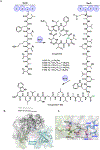Biosynthetic Cyclization Catalysts for the Assembly of Peptide and Polyketide Natural Products
- PMID: 34335987
- PMCID: PMC8320681
- DOI: 10.1002/cctc.202001886
Biosynthetic Cyclization Catalysts for the Assembly of Peptide and Polyketide Natural Products
Abstract
Many biologically active natural products are synthesized by nonribosomal peptide synthetases (NRPSs), polyketide synthases (PKSs) and their hybrids. These megasynthetases contain modules possessing distinct catalytic domains that allow for substrate initiation, chain extension, processing and termination. At the end of a module, a terminal domain, usually a thioesterase (TE), is responsible for catalyzing the release of the NRPS or PKS as a linear or cyclized product. In this review, we address the general cyclization mechanism of the TE domain, including oligomerization and the fungal C-C bond forming Claisen-like cyclases (CLCs). Additionally, we include examples of cyclization catalysts acting within or at the end of a module. Furthermore, condensation-like (CT) domains, terminal reductase (R) domains, reductase-like domains that catalyze Dieckmann condensation (RD), thioesterase-like Dieckmann cyclases, trans-acting TEs from the penicillin binding protein (PBP) enzyme family, product template (PT) domains and others will also be reviewed. The studies summarized here highlight the remarkable diversity of NRPS and PKS cyclization catalysts for the production of biologically relevant, complex cyclic natural products and related compounds.
Keywords: Biocatalysis; Enzymes; Natural Products; Nonribosomal Peptide Synthetase; Polyketide Synthase.
Figures






















Similar articles
-
Structure and function of an iterative polyketide synthase thioesterase domain catalyzing Claisen cyclization in aflatoxin biosynthesis.Proc Natl Acad Sci U S A. 2010 Apr 6;107(14):6246-51. doi: 10.1073/pnas.0913531107. Epub 2010 Mar 23. Proc Natl Acad Sci U S A. 2010. PMID: 20332208 Free PMC article.
-
Analysis of the enzymatic domains in the modular portion of the coronafacic acid polyketide synthase.Gene. 2001 May 30;270(1-2):191-200. doi: 10.1016/s0378-1119(01)00476-0. Gene. 2001. PMID: 11404016
-
Structural insights into the regulation of NADPH binding to reductase domains of nonribosomal peptide synthetases: A concerted loop movement model.J Struct Biol. 2016 Jun;194(3):368-74. doi: 10.1016/j.jsb.2016.03.014. Epub 2016 Mar 16. J Struct Biol. 2016. PMID: 26993465
-
Cyclic natural product oligomers: diversity and (bio)synthesis of macrocycles.Chem Soc Rev. 2025 Jan 2;54(1):396-464. doi: 10.1039/d2cs00909a. Chem Soc Rev. 2025. PMID: 39584260 Review.
-
Ways of assembling complex natural products on modular nonribosomal peptide synthetases.Chembiochem. 2002 Jun 3;3(6):490-504. doi: 10.1002/1439-7633(20020603)3:6<490::AID-CBIC490>3.0.CO;2-N. Chembiochem. 2002. PMID: 12325005 Review.
Cited by
-
Macrocyclizing-thioesterases in bacterial non-ribosomal peptide biosynthesis.J Nat Med. 2025 Jan;79(1):1-14. doi: 10.1007/s11418-024-01841-y. Epub 2024 Aug 30. J Nat Med. 2025. PMID: 39214926 Free PMC article. Review.
-
Directed Evolution of a Modular Polyketide Synthase Thioesterase for Generation of a Hybrid Macrocyclic Ring System.ACS Catal. 2025 Feb 21;15(4):3405-3417. doi: 10.1021/acscatal.4c07922. Epub 2025 Feb 11. ACS Catal. 2025. PMID: 40386551 Free PMC article.
-
Enzymatic synthesis of fluorinated compounds.Appl Microbiol Biotechnol. 2021 Nov;105(21-22):8033-8058. doi: 10.1007/s00253-021-11608-0. Epub 2021 Oct 9. Appl Microbiol Biotechnol. 2021. PMID: 34625820 Free PMC article. Review.
-
Effects of the deletion and substitution of thioesterase on bacillomycin D synthesis.Biotechnol Lett. 2023 Aug;45(8):981-991. doi: 10.1007/s10529-023-03373-z. Epub 2023 Jun 2. Biotechnol Lett. 2023. PMID: 37266877
-
Thioesterase enzyme families: Functions, structures, and mechanisms.Protein Sci. 2022 Mar;31(3):652-676. doi: 10.1002/pro.4263. Epub 2022 Jan 4. Protein Sci. 2022. PMID: 34921469 Free PMC article.
References
-
- Du L, Lou L, Nat. Prod. Rep 2010, 27, 255–278. - PubMed
Grants and funding
LinkOut - more resources
Full Text Sources
Molecular Biology Databases
Research Materials
Miscellaneous
